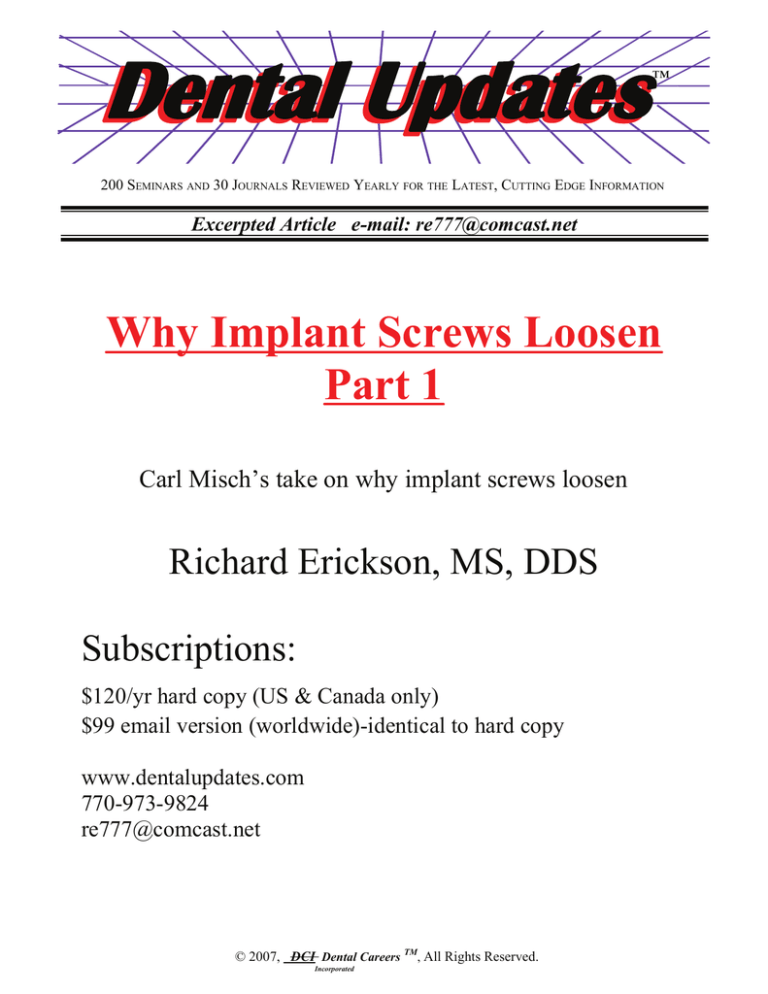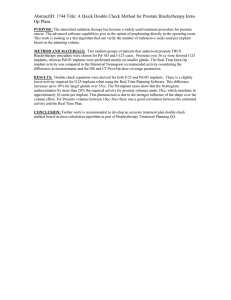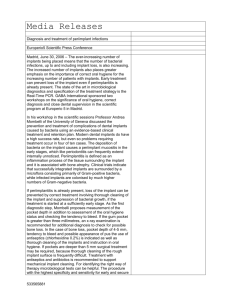
¼ ½ ¾ µ mW/cm2
Volume 17; 2007
Dental Updates
™
"CUTTING EDGE INFORMATION FOR THE DENTAL PROFESSIONAL "
200 SEMINARS AND 30 JOURNALS REVIEWED YEARLY FOR THE LATEST, CUTTING EDGE INFORMATION
Excerpted Article e-mail: re777@comcast.net
Why Implant Screws Loosen
Part 1
Carl Misch’s take on why implant screws loosen
Richard Erickson, MS, DDS
Subscriptions:
$120/yr hard copy (US & Canada only)
$99 email version (worldwide)-identical to hard copy
www.dentalupdates.com
770-973-9824
re777@comcast.net
© 2007, DCI Dental Careers TM, All Rights Reserved.
Incorporated
30
Single Tooth Implant
According to Misch, a single tooth implant success rate is above 98% and unlike a bridge,
the adjacent teeth are no more at risk than if no tooth was missing. Accordingly, the only option dentists
should give to patients for single tooth replacement is an implant. For the maintenance of bone, the
health of adjacent teeth, the longevity of the restoration, a single tooth implant is the treatment of choice.
Some general rules of implant placement will serve to illustrate that implant surgery is not
rocket science:
1. For a bicuspid space of 6-7mm, a 4mm wide implant is used
2. If the mandibular canal is m 9mm from the crest of the bone, the tissue does not even need to be
flapped to place the implant.
3. Most smokers are acceptable candidates for implants as they experience only a slightly higher
failure rate.
4. If patient is a bruxer, and missing both 1st and 2nd molars, use 3 implants to replace 2 molars.
5. If there are two adjacent implants, splint the restorations together. There is no reason to have
independent tooth implants as hygiene is not a problem.
6. If the implant is placed too close to the root of an adjacent tooth, simply remove the implant, let
it heal and redo it, no big deal.
Implant Considerations and Complications
There are some special considerations regarding implants which must be factored in their use
to avoid problems. They include:
{ Patients put a HIGHER bite force on implants than regular teeth, therefore some implant problems
are a result of this increased stress.
{ Impact forces are GREATER on implants due to the patient's lack of proprioception. Therefore
overload conditions on implants may go unnoticed.
{ Because a natural tooth can be depressed 28µ and can deflect away from a downward force, the
bone and natural tooth can accommodate to chewing forces very well. On the contrary, an implant
cannot accommodate to excessive stress like natural teeth and may become loose and remain
loose. Bone loss around an implant is almost always due to excess stress. Bacteria infiltration
may occur SECONDARILY to the bone loss caused by stress.
{ Those in academia maintain that bone loss around an implant has nothing to do with stress,
however this concept is FALSE.
31
{ Bone loss around an implant IS directly related to excess stress which may be a result of any of
the following three factors: 1. Occlusal stress; 2. Insufficient implant size; 3. An inadequate
number of implants used for a given space.
{ Because the implant abutments are generally smaller than natural tooth abutments, the lab may
make a standard thickness COPING which will then require an overly thick (>2mm) layer of
porcelain. Fired porcelain which is more than 2mm thick is weak and will fracture easily.
Therefore, inform the lab to design the coping so that the resulting porcelain will be [ 2mm thick
in all areas.
Implant Screw Loosening Problems
For me and any dentist who has restored implants, screw loosening represents one of the
most frustrating problems encountered. Some have claimed that the "internal hex" design and proper
torque will minimize the problem. The tips below may provide additional insights to all but eliminate
this problem.
In a study of 70 implants, 57% of abutment screws become loose during the first year. After
three years, only 35% of the implants in the study remained tight without incident. In another study of
107 implants, 26% suffered screw loosening the first year. This frustrating problem may be part of the
reason why GPs are not embracing implant technology with more enthusiasm. As Misch points out
however, screw loosening is not related to implant design but rather bruxism and several other
controllable factors:
1. If the occlusal table of the implant tooth is NARROWED, there is less screw loosening.
2. Stress on the screw can be decreased by decreasing the crown height, increasing the hex height
(though most companies hex is 0.7mm
high) and perhaps the best solution for
decreasing stress on the screw is to
INCREASE the DIAMETER of the
implant.
3. When using a torque wrench to tighten
the screw, the ABUTMENT should be
held securely with a small hemostat so
the implant will not turn when the
screw is torqued.
4. Torque
wrenches
LOSE
CALIBRATION
with
use
and
autoclaving and should be returned to
the manufacturer for re-calibration periodically.
5. An implant outside the ESTHETIC ZONE (i.e. in the posterior) should NOT have normal
anatomical cuspal inclines as these will greatly increase the LATERAL FORCES on the implant
and contribute to screw loosening, bone loss and failure rate. A wide central fossa area centered
over the implant is desirable. These two photos of implants posterior to tooth #20 illustrate how
32
"molar" implants should be fabricated. They are no larger than the 2nd bicuspid natural tooth
and have flat plane occlusion.
6. Therefore, if the implant tooth is not in the esthetic zone, it should be NARROWER and have
basically FLAT PLANE occlusion to avoid unnecessary forces (see also Adjusting the Occlusion
of Implants). As Misch often says, "If the implant tooth is out of the esthetic zone and I have
made it LOOK like a tooth, I have made it INCORRECTLY."
Implant Design and Treatment Considerations
{ The DIAMETER of the implant and the DESIGN of the implant (more surface area is better) are
key factors and are paramount for implant
success. The wider the diameter of the
implant, the better the distribution of
stresses will be.
{ LENGTH of the implant is NOT the most
important factor in stress distribution as the
stress is only at the top 5-8mm of the
implant and is concentrated at the crest of
the ridge, so a longer implant will not be
better. The ultimate dynamic strength of natural teeth, vis à vis crown-to-root ratios, have no basis
in fact when it comes to implant design. The implants at left come in lengths of 9, 12, and 15 mm
and widths of 3.5, 4.0 and 5.0mm.
{ In planning a case, the implant size (diameter most critical) should be selected by what is needed
to support the case. Perform bone grafts if necessary to support this selection, rather than fitting
the size of the implants to the existing anatomic conditions, as is often the case.
{ The NUMBER of implants to be placed should be dictated by what is needed for success (i.e. four
teeth to be replaced = 3-4 implants used) and NOT by how many implants the existing bone can
support. This decision unfortunately is often made by a specialist who does not have to restore
and be responsible for the ultimate success or failure of the case! If the bone is not present to
support the number of implants needed then it should be "grown" first via
grafting procedures.
{ PLAIN CYLINDER implants (left) have less surface area than
THREADED ones (right) and are prone to a
higher failure rate. The higher the number
of threads, the greater the surface area and
the greater the chance for long term
success. TAPERED implants have less
surface area than NON-TAPERED.
{ Use WIDER implants and MORE of them
in molar areas.
33
{ Implants placed at angles other than absolutely VERTICAL (perpendicular to the biting force)
because of placement imprecision are thought to be irrelevant
because the implant companies have conveniently made angled
abutments to compensate for this. Unfortunately, it is NOT
IRRELEVANT as now the forces of occlusion will be dissipated on
the SIDE of the implant rather than impacting parallel to its long
axis. Off-angled implants with compensating abutments will have
increased screw stress, increased screw loosening and increased
chances for crestal bone loss on the side of the implant absorbing
the force. The implants at left are all off-vertical (exaggerated) and while the angled abutments
have corrected it, the complications mentioned above may be the
sequelae.
{ Because of anatomic considerations in the anterior, one cannot
help but have implants placed at angles well off from the
occlusal force axis. Fortunately, the force of occlusion is the
lowest in the anterior region (35 lbs. vs 200 lbs.) so the effect is
minimized. Nevertheless, bone loss is typically seen in anterior
implants on the buccal as that is the side of the implant which
absorbs the force. The xray at left shows two well placed
implants in the posterior region and are correctly parallel to the
occlusive forces.
Occlusal Adjustments of Implants
Adjusting the occlusion of implanted prosthetics requires special consideration. As
mentioned before, since proprioception of occlusive force in implants is nonexistent, the implant must
be protected from the excess forces described earlier.
Natural teeth compress 27µ downward and 50-100µ laterally during function. Implants, of
course, do not move at all. Visual acuity allows one to only "see" movement > 80µ. If the occlusion on
a newly restored implant is adjusted to light tapping in the usual manner, the implant will be in
HYPEROCCLUSION and subjected to excessive stress during normal function.
Occlusal adjustment and marking of implants therefore needs to be done under HEAVY
biting pressure in order to fully compress the natural teeth. A very thin articulating paper (Accu-Film;
Parkell) should be used to accurately record prematurities. Under full biting pressure, any heavy
occlusive marks need to be relieved, otherwise bone loss around the implant may occur as early as one
month. Again, the patient will not be able to "tell" that the implant is too high as there is no
proprioception.
The only occlusal contact for an implant crown should be in its central fossa, directly over
the implant. Occlusal contact on the marginal ridges will increase chances for screw loosening, bone
loss and porcelain fracture. The occlusal table of an implant should NEVER mimic natural dentition.
The best occlusion for posterior implants is posterior disclusion. This will decrease the
lateral forces on the implant during function.







